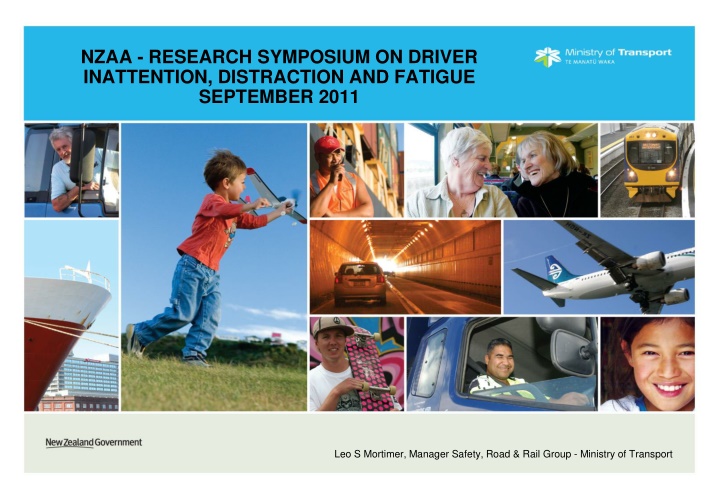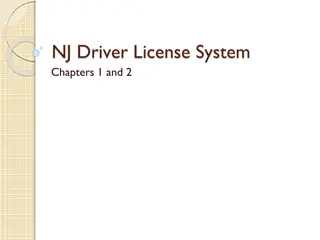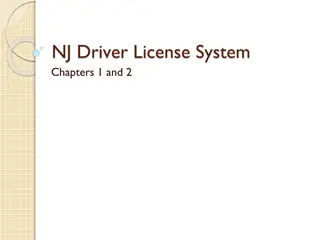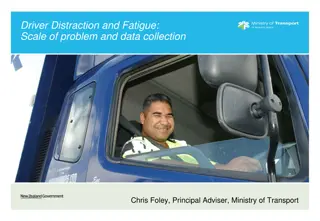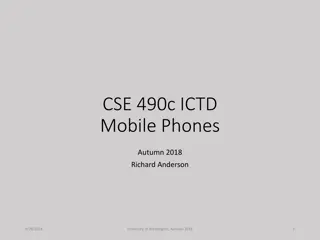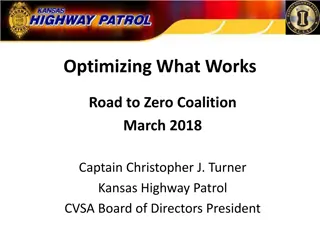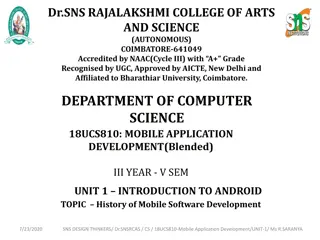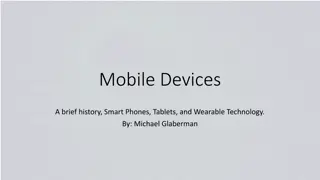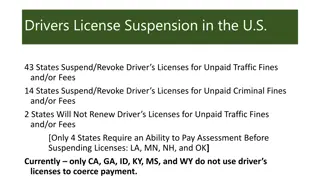Impact of Mobile Phone Regulations on Driver Distraction
The research symposium focused on driver inattention, distraction, and fatigue. It explored the role of regulation in behavioral change, specifically the introduction of a cell phone ban to reduce risks associated with driver distraction. Options such as publicity campaigns, comprehensive bans, or doing nothing were discussed. The social costs of crashes involving mobile phones were outlined, along with estimates of cost reduction and benefit-to-cost ratios under different scenarios. Consultation results showed majority support for banning hand-held mobile phones while driving, although enforcement challenges and considerations for hands-free devices were raised.
Download Presentation

Please find below an Image/Link to download the presentation.
The content on the website is provided AS IS for your information and personal use only. It may not be sold, licensed, or shared on other websites without obtaining consent from the author.If you encounter any issues during the download, it is possible that the publisher has removed the file from their server.
You are allowed to download the files provided on this website for personal or commercial use, subject to the condition that they are used lawfully. All files are the property of their respective owners.
The content on the website is provided AS IS for your information and personal use only. It may not be sold, licensed, or shared on other websites without obtaining consent from the author.
E N D
Presentation Transcript
NZAA - RESEARCH SYMPOSIUM ON DRIVER INATTENTION, DISTRACTION AND FATIGUE SEPTEMBER 2011 Leo S Mortimer, Manager Safety, Road & Rail Group - Ministry of Transport
The role of regulation Various forms of bring about behavioural change The introduction of the cell phone ban as an example When do you regulate? What do you regulate?
Objectives Mobile phones The public policy objective is to reduce the risks caused by driver distraction, particularly those related to the use of hand-held communication devices.
Options Publicity campaign to increase driver awareness A comprehensive ban on using a mobile phone while driving Banning the use of hand-held mobile phones while driving Do nothing
Over this six year period the social cost associated with these crashes is estimated at $187.9 million Table 1. Crashes where mobile phone communications device was a contributing factor and social cost Total crashes Social cost (2008$, real) Year Fatal Injury 2003 4 46 50 21.7m 2004 5 59 64 31.8m 2005 7 72 79 42.5m 2006 2 93 95 27.0m 2007 6 96 102 38.5m 2008 1 116 117 26.6m
Estimated reduction in social cost of mobile phone related crashes (2008$, real terms) Year 2010 2011 2012 2013 2014 High $9.1m $10.0m $10.9m $11.7m $12.6m Low $7.6m $7.6m $7.6m $7.6m $7.6m
Estimated benefit to cost ratio under different scenarios High benefit Low benefit High cost 1.7 1.3 Low cost 3.3 2.5
Consultation 53 submissions discussed the proposal to ban the use of hand-held mobile phones while driving unanimously (at least in principal) in favour of a ban on the use of hand-held mobile phones while driving. banning the use of hand-held mobile phones would be difficult to enforce. A number of submitters supported the hands free rather than a total ban While many others said the use of hands-free mobile phones should also be banned. prohibit their use would be costly to businesses and the economy,
What was the public saying? Broad public support for the banning of hand- held mobile phones. A NZ Automobile Association poll at that time said 76 percent of its members supported a ban on the use of hand-held mobile phones A recent Research New Zealand poll revealed 86 percent public support for a ban on the use of hand-held mobile phones while driving
Casualties in mobile phone crashes Casualties in crashes where 'cell phone' was identified as a contributing factor; (prior to late 2009 other 'communications devices' were also included) (hand held devices are not identified separately) (law forbidding use of hand held devices while driving took effect Nov 2009) Year Fatal Serious Minor 2005 10 14 81 2006 2 22 101 2007 8 15 121 2008 1 24 133 2009 5 15 72 2010 5 15 73
Mobile phone crashes Crash severity Crashes where mobile phone' was identified as a contributing factor (prior to late 2009 other 'communications devices' were also included) (hand held devices are not identified separately) (national data for causes for non-injury crashes began in 2007) (law forbidding use of hand held devices while driving took effect Nov 2009) Year Fatal Serious 2005 7 11 2006 2 20 2007 6 15 2008 1 22 2009 5 13 2010 5 13 Minor 62 77 85 96 63 50 Non-injury 223 218 174 129
Questions Leo S Mortimer Manager Safety - Road & Rail Group Ministry of Transport L.mortimer@transport.govt.nz
